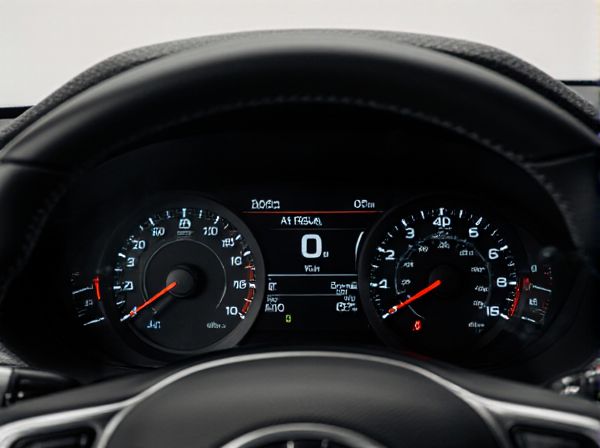
Photo illustration: Analog Cluster vs Digital Cluster
Digital clusters offer sharper displays and customizable layouts, enhancing your driving experience with real-time information and alerts. Analog clusters provide traditional, easy-to-read gauges that many drivers find reliable and familiar, especially in classic or performance vehicles. Choosing between analog and digital clusters depends on your preference for modern technology or classic simplicity.
Table of Comparison
| Feature | Analog Cluster | Digital Cluster |
|---|---|---|
| Display Type | Mechanical needles and dials | High-resolution LCD or OLED screen |
| Customization | Fixed layout, limited customization | Fully customizable interface and layouts |
| Information Display | Basic speed, fuel, RPM, temperature | Comprehensive data: navigation, multimedia, vehicle status |
| Visibility | Good in daylight, limited night clarity | Enhanced visibility with adjustable brightness and night modes |
| Reliability | Highly reliable, minimal electronic failure | Depends on software and electronics, possible glitches |
| Cost | Lower manufacturing and repair costs | Higher initial cost and maintenance expenses |
| Driver Experience | Classic feel, easy readability | Modern, interactive, and information-rich |
Introduction to Analog and Digital Clusters
Analog clusters utilize traditional needle gauges and physical dials to display vital vehicle information such as speed, fuel level, and engine temperature, providing intuitive, real-time feedback through mechanical movement. Digital clusters replace these mechanical components with high-resolution LCD or OLED screens, allowing dynamic customization of the dashboard interface, integration of advanced driver-assistance data, and enhanced readability under various lighting conditions. The transition from analog to digital clusters marks a significant evolution in automotive instrumentation, offering greater flexibility and connectivity in modern vehicles.
What is an Analog Cluster?
An Analog Cluster consists of traditional mechanical gauges with physical needles to display vehicle information such as speed, fuel level, and engine temperature. These clusters rely on electromagnetic or stepping motors to move the needles in real time, providing an intuitive and easily readable interface. Compared to digital clusters, analog clusters offer straightforward reliability but lack the customizable displays and advanced data integration found in modern vehicles.
What is a Digital Cluster?
A digital cluster is an advanced instrument panel in vehicles that replaces traditional analog gauges with a fully digital display, providing customizable and dynamic information such as speed, fuel level, and navigation data. It uses high-resolution LCD or OLED screens to enhance driver interaction and improve readability under various lighting conditions. Unlike analog clusters, digital clusters allow for software updates and integration with vehicle infotainment systems, offering a more versatile and modern driving experience.
Key Differences Between Analog and Digital Clusters
Analog clusters display vehicle information using mechanical gauges with needles, offering a traditional and easily readable interface. Digital clusters utilize high-resolution screens to present customizable and dynamic data, enhancing driver interaction through advanced graphics and real-time updates. Key differences include the precision of data presentation, customization options, and integration with modern vehicle systems.
Advantages of Analog Clusters
Analog clusters offer superior readability due to their continuous needle movement, allowing drivers to gauge speed and engine RPM intuitively at a glance. They provide tactile feedback and a classic aesthetic appeal that many drivers prefer for its simplicity and reliability. Lower production cost and easier maintenance make analog clusters advantageous for budget-conscious vehicle designs.
Advantages of Digital Clusters
Digital clusters offer superior customization and flexibility compared to analog clusters, allowing drivers to personalize display layouts and access real-time data with enhanced clarity. They provide seamless integration with advanced vehicle systems, enabling features like navigation, multimedia controls, and driver assistance information in a dynamic interface. Enhanced readability under various lighting conditions and reduced mechanical wear further contribute to the durability and user-friendly experience of digital clusters.
Performance and Accuracy Comparison
Digital clusters offer superior accuracy due to precise electronic signal processing, eliminating the mechanical limitations found in analog clusters. Performance-wise, digital clusters provide faster response times and customizable displays, enhancing driver information accessibility and reliability. Analog clusters, while simpler and less costly, often suffer from mechanical wear and slower update rates, resulting in less precise readings compared to digital counterparts.
Customization and User Experience
Analog clusters offer limited customization, with fixed gauge designs and basic indicator lights, appealing to users who prefer a traditional, straightforward interface. Digital clusters enable extensive customization, allowing drivers to personalize displays for navigation, multimedia, and vehicle data, enhancing user interaction and convenience. The digital interface typically improves user experience by providing clearer visuals, real-time updates, and interactive controls tailored to individual preferences.
Future Trends in Automotive Instrument Clusters
Digital clusters are rapidly replacing analog clusters in automotive applications due to their enhanced customization, real-time data integration, and improved driver interface. Future trends in automotive instrument clusters emphasize augmented reality (AR) displays, seamless smartphone connectivity, and adaptive interfaces powered by artificial intelligence (AI) to deliver personalized driving experiences. The shift towards fully digital, high-resolution screens supports advanced driver-assistance systems (ADAS) and autonomous vehicle functionalities, positioning digital clusters as the cornerstone of next-generation automotive design.
Which Cluster Type is Best for You?
Choosing between an analog cluster and a digital cluster depends on your driving preferences and vehicle use. Analog clusters offer a classic, easy-to-read interface with physical gauges that provide real-time feedback, ideal for traditional drivers who value tactile feedback. Digital clusters provide customizable displays and advanced features like navigation and performance data, best suited for tech-savvy users who prefer a modern and versatile dashboard experience.
 caratoz.com
caratoz.com